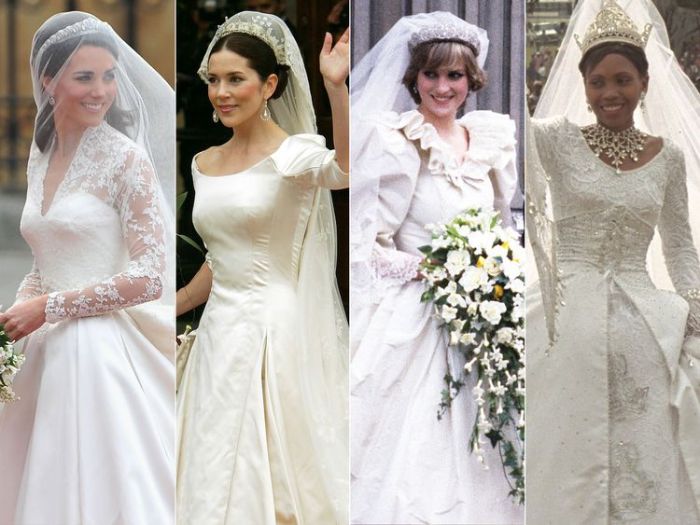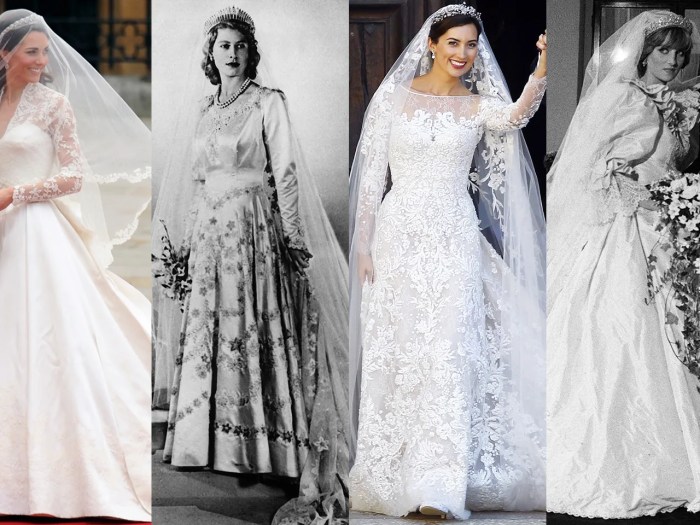A Regal History: Tracing the Evolution of Royal Wedding Dresses: Best Royal Wedding Dresses

Source: people.com
Best royal wedding dresses – Royal weddings are more than just celebrations of love; they are significant cultural events, often shaping fashion trends and reflecting societal values. The wedding dress, a central element of these spectacles, has undergone a remarkable evolution throughout history, mirroring changing aesthetics and reflecting the personalities of the brides themselves. This exploration delves into the fascinating history of royal wedding gowns, examining their design, symbolism, and lasting impact.
Historical Context of Royal Wedding Dresses
Royal wedding dress styles have dramatically shifted over the centuries. Early royal brides often wore richly embroidered gowns in vibrant colors, reflecting the opulent lifestyles of the era. The introduction of white dresses, beginning in the 19th century with Queen Victoria’s iconic gown, marked a significant turning point, establishing white as the quintessential color for bridal wear. This choice, symbolizing purity and innocence, became a lasting tradition.
Royal wedding dresses often set trends, showcasing exquisite craftsmanship and timeless elegance. The choice of fabric, design, and embellishments are meticulously considered, resulting in iconic gowns. However, the quest for the perfect attire extends beyond royalty; finding the best dress of wedding is a significant undertaking for any bride. Ultimately, the most memorable royal wedding dresses share a common thread: they reflect the bride’s personality and the significance of the occasion.
The 20th and 21st centuries have seen further diversification, with royal brides incorporating modern design elements and personal preferences while still adhering to certain traditional aspects.
Examples of iconic dresses include Queen Victoria’s simple yet elegant Honiton lace gown (1840), which set the standard for future royal brides; Grace Kelly’s elegant, high-necked gown by Helen Rose (1956), a symbol of Hollywood glamour; and Diana, Princess of Wales’s voluminous, puffed-sleeve gown by David and Elizabeth Emanuel (1981), which captured the romantic spirit of the era. Each dress reflects the societal trends and cultural influences of its time, from the Victorian era’s emphasis on simplicity to the 1980s’ penchant for romantic extravagance.
A timeline highlighting key moments in royal wedding dress fashion would showcase the progression: The shift from colored gowns to white; the rise of elaborate lace and embroidery; the adoption of different silhouettes (e.g., A-line, empire waist, ballgown); and the increasing incorporation of modern design elements and personal expression.
Designers and Their Impact

Source: vanityfair.com
Several prominent designers have shaped the landscape of royal wedding dresses, each with a distinct design philosophy. These designers collaborate closely with the royal brides, blending the bride’s personal style with their expertise to create a truly unique and memorable gown. The collaborative process is crucial, ensuring the final design reflects both the bride’s vision and the tradition associated with royal weddings.
| Designer | Bride | Year | Notable Features |
|---|---|---|---|
| Norman Hartnell | Queen Elizabeth II | 1947 | Ivory satin, embroidered with thousands of pearls and crystals |
| Helen Rose | Grace Kelly | 1956 | High-necked, long-sleeved gown with intricate lace detailing |
| David and Elizabeth Emanuel | Diana, Princess of Wales | 1981 | Puffed sleeves, voluminous skirt, antique lace |
| Alexander McQueen | Catherine, Duchess of Cambridge | 2011 | Lace bodice, long train, satin skirt |
Fabrics, Silhouettes, and Embellishments
Royal wedding dresses typically feature luxurious fabrics, often imbued with symbolic meaning. Silk, satin, lace, and organza are common choices, symbolizing opulence, purity, and elegance. Silhouettes have varied throughout history, from the full ballgowns of the Victorian era to the more streamlined A-line and mermaid styles of recent decades. Intricate embellishments, including lace, embroidery, beading, and appliqués, further enhance the grandeur and artistry of these gowns.
Visual Representation (Description): Imagine a series of swatches. One showcases the smooth, lustrous sheen of ivory silk satin; another depicts the delicate, intricate pattern of Honiton lace; a third reveals the rich texture of hand-embroidered floral motifs on organza; and a final swatch displays the subtle sparkle of delicately beaded tulle. Each swatch is a representation of the unique texture and visual appeal of these fabrics and embellishments, commonly seen in royal wedding gowns.
The Symbolism and Meaning, Best royal wedding dresses
The color, design elements, and overall aesthetic of a royal wedding dress carry significant symbolic weight. White, the most common choice, symbolizes purity and innocence. Other colors, while less frequent, can hold cultural or historical connotations. The choice of fabrics, embellishments, and silhouette also contributes to the dress’s overall message, often reflecting national identity and projecting a specific image.
The dress becomes a powerful symbol, balancing tradition with the bride’s personal style.
Modern Interpretations of Royal Wedding Dress Traditions

Source: cloudfront.net
Modern royal wedding dresses retain elements of tradition while incorporating contemporary design sensibilities. While white remains the dominant color, recent years have seen a shift toward more fitted silhouettes, less elaborate embellishments, and a greater emphasis on individual style. This evolution demonstrates a subtle but significant departure from the more formal and heavily ornamented gowns of previous generations. The influence of contemporary fashion trends is undeniable, creating a balance between timeless elegance and modern aesthetics.
- Meghan Markle (2018): Clean lines, simple elegance, bateau neckline.
- Princess Eugenie (2018): Low back, long sleeves, fitted silhouette with a more modern feel.
- Princess Beatrice (2020): Vintage-inspired, re-purposed dress, showcasing sustainability and a unique approach.
The Influence on Popular Culture and Fashion
Royal wedding dresses have a profound and lasting impact on popular culture and wedding dress trends. The gowns often inspire countless copies and adaptations, influencing designers and brands to create similar styles. The media’s role in disseminating images and narratives surrounding these dresses significantly shapes public perception and appreciation, creating a ripple effect throughout the fashion industry. This influence ensures that the legacy of these iconic dresses continues to resonate long after the wedding day.
- Queen Victoria’s dress: popularized the white wedding dress.
- Grace Kelly’s dress: inspired countless high-necked, elegant gowns.
- Diana’s dress: popularized the voluminous, romantic style.
FAQ Overview
What is the average cost of a royal wedding dress?
The cost varies greatly depending on the designer, fabrics, and embellishments, but it can range from hundreds of thousands to millions of dollars.
Who typically designs royal wedding dresses?
Royal wedding dresses are often designed by renowned couture houses or established designers known for their exquisite craftsmanship and experience with high-profile clients.
Are royal wedding dresses always white?
While white has become the dominant color, historically, royal brides have worn various colors, reflecting cultural norms and personal preferences.
What happens to royal wedding dresses after the wedding?
Many are preserved in royal archives or museums, while others may be kept privately by the bride.